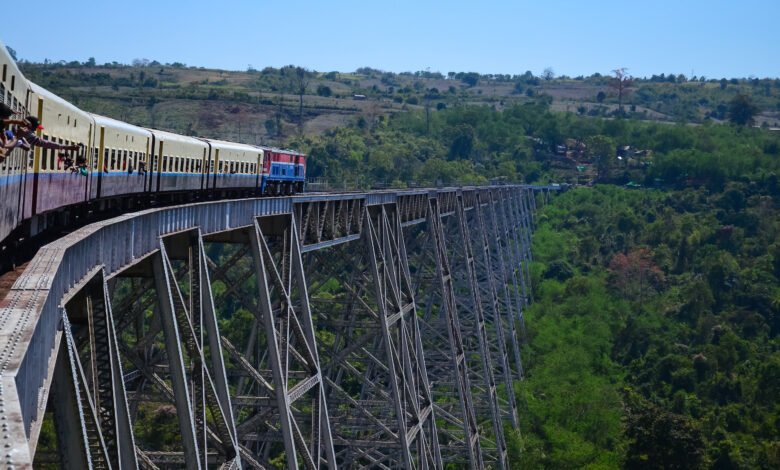All Aboard! Exploring Muzaffarnagar Railway Station: Gateway to Western Uttar Pradesh

Nestled in the bustling heart of Uttar Pradesh’s sugarcane belt, Muzaffarnagar Railway Station (Station Code: MOZ) stands as a vital artery of transportation and a testament to the region’s connectivity. Far more than just a stop on the map, this station serves as a crucial junction linking the agricultural and industrial hub of Muzaffarnagar district to major cities across North India. From the daily hustle of commuters and students to the thunderous passage of long-distance expresses, the station pulsates with the rhythm of countless journeys. Its platforms witness the convergence of diverse lives – traders moving goods, families reuniting, pilgrims embarking on spiritual trails, and workers seeking opportunities afar. Steeped in the practical realities of a key transit point, Muzaffarnagar Railway Station is an indispensable lifeline for the region, facilitating movement, commerce, and connection in a dynamic part of the country.
Headings and Detailed Explanations:
-
A Historical Anchor: Tracing Muzaffarnagar Station’s Legacy
Muzaffarnagar Railway Station’s origins are deeply intertwined with the expansion of the British Indian railway network in the late 19th and early 20th centuries. Primarily established to serve the burgeoning agricultural trade, particularly the vast sugarcane and jaggery (gur) industry that the district was (and remains) famous for, it provided a critical link for transporting raw materials and finished products to major markets like Delhi, Kolkata, and beyond. Its development mirrored the growth of the town itself, evolving from a basic halt to a more significant station as rail traffic increased. While specific construction dates might be less documented than grand termini, its establishment solidified Muzaffarnagar’s position as a key commercial center in the Upper Doab region. Over the decades, the station has witnessed the transformation of India, from the colonial era through independence, adapting and expanding to meet the ever-growing demands of passenger and freight traffic, silently carrying the weight of the region’s economic and social history on its tracks. -
Strategic Location and Regional Connectivity Hub
Muzaffarnagar Station’s significance is amplified by its strategic location on the Delhi-Saharanpur-Laksar-Dehradun line, a crucial corridor in the Northern Railway zone. Positioned approximately 130 kilometers northeast of the national capital, Delhi, and acting as a major station for the surrounding rural and semi-urban hinterland, it serves as a primary railhead for a vast population. Its connectivity extends far beyond immediate neighbors. Direct train links efficiently connect Muzaffarnagar to major destinations like Delhi, Meerut, Saharanpur, Haridwar, Dehradun, Amritsar, Lucknow, Varanasi, Kolkata, Mumbai, and Ahmedabad, among others. This extensive network makes it an essential transit point not just for residents of Muzaffarnagar city and district, but also for people from adjoining districts like Shamli, Baghpat, and parts of Haryana who rely on it for long-distance travel, pilgrimage, education, and business commuting, solidifying its role as a regional powerhouse of rail connectivity. -
Infrastructure and Passenger Amenities: Navigating the Station
Muzaffarnagar station presents a blend of older structures and ongoing modernization efforts typical of busy Indian railway junctions. It features multiple platforms capable of handling numerous trains simultaneously, including longer expresses. Key infrastructure includes a footbridge connecting the platforms, essential for passenger movement and safety. While basic, the station provides fundamental amenities: waiting halls (often segregated), reservation counters, and computerized ticket booking facilities. Passengers will find essential food stalls, tea vendors, bookstalls, and basic luggage porters. Public conveniences and drinking water facilities are available. However, like many stations of its size and age, it often faces challenges during peak hours with crowding, and amenities can feel stretched thin. Recent improvements under station enhancement schemes might include better lighting, signage, or facade work, but the core experience remains that of a functional, bustling workhorse station prioritizing movement over luxury, constantly adapting to the heavy traffic it bears. -
Train Services: The Lifelines on the Tracks
The lifeblood of Muzaffarnagar Station is the constant ebb and flow of diverse train services. It witnesses a significant volume of traffic, encompassing a wide spectrum:-
Passenger Trains: Slower, stopping services connecting nearby towns and villages (e.g., to Meerut, Saharanpur, Shamli, Deoband).
-
Express & Mail Trains: The backbone of long-distance travel, including major trains like the Dehradun Express, Howrah Express, Amritsar Express, Mumbai Central Superfast, Lucknow Mail, and numerous others connecting it to every corner of India.
-
MEMU (Mainline Electric Multiple Unit): Providing faster commuter services on electrified sections, particularly useful for travel towards Delhi, Meerut, and Saharanpur, offering a middle ground between slow passengers and expensive expresses.
-
Freight Services: Critical for the local economy, transporting sugarcane, gur, grain, industrial raw materials, and finished goods. The frequency and variety of trains make the station exceptionally busy, requiring efficient management to handle schedules and passenger flow, especially during festive seasons or harvest times when demand surges dramatically.
-
-
Economic Engine and Social Catalyst
The impact of Muzaffarnagar Railway Station extends far beyond transportation; it is a vital engine for the district’s economy and a catalyst for social mobility. For the dominant sugarcane and agricultural sector, it provides an indispensable link for farmers to send their produce to sugar mills within the district and far beyond, and for bringing in essential fertilizers and machinery. The station facilitates the movement of workers to industrial areas in Delhi-NCR, Meerut, and Saharanpur, and enables traders to access national markets for goods like jaggery, paper (from local mills), and textiles. Socially, it connects students to educational institutions in major cities, allows families separated by migration to reunite, and enables pilgrims to visit holy sites like Haridwar and Varanasi. It acts as a crucial equalizer, providing relatively affordable access to opportunities across the country for people from all walks of life in the region, fostering integration and development. -
Challenges and the Path Forward: Modernization and Enhancement
Despite its critical role, Muzaffarnagar Station faces significant challenges that impact passenger experience and operational efficiency. Chronic overcrowding, especially during peak hours and festive seasons, is a major concern. Aging infrastructure, while functional, often struggles to cope with the current volume of traffic and passenger expectations for modern amenities. Parking facilities are typically inadequate and chaotic, causing congestion in the station approach areas. Sanitation and maintenance can be inconsistent. Looking ahead, the focus is on modernization: potential platform extensions, upgrading waiting areas and restrooms, improving signage and passenger information systems, enhancing security (CCTV), and developing better organized parking and circulation plans. Proposals for more MEMU services and better frequency of key trains are perennial demands. Addressing these challenges is crucial to transform MOZ from a purely functional node into a more comfortable, efficient, and modern gateway that truly reflects the importance of the region it serves.
FAQ (Frequently Asked Questions):
-
Q: What is the station code for Muzaffarnagar Railway Station?
A: The official station code for Muzaffarnagar Railway Station is MOZ. -
Q: Which railway zone manages Muzaffarnagar Station?
A: Muzaffarnagar Station falls under the administrative control of the Northern Railway (NR) zone of Indian Railways. -
Q: What are some major cities directly connected by train from Muzaffarnagar?
A: Muzaffarnagar has direct train connections to numerous major cities including Delhi, Meerut, Saharanpur, Haridwar, Dehradun, Lucknow, Varanasi, Kolkata, Mumbai, Amritsar, Ahmedabad, Jaipur, and Chandigarh, among others. -
Q: Are there good options for commuting daily to Delhi/NCR from Muzaffarnagar by train?
A: Yes, commuting is feasible but requires planning. Several Passenger trains and MEMU services operate frequently between Muzaffarnagar and stations like Meerut City, Ghaziabad, and Delhi (Old Delhi, New Delhi, Anand Vihar). However, travel time is significant (3+ hours to Delhi), and trains can be very crowded during peak commuting hours. Many commuters find a combination of train and metro/bus from Meerut/Ghaziabad more practical. -
Q: What facilities can I expect at the station?
A: Expect basic but essential facilities: Waiting halls, reservation counters, computerized ticket windows, food stalls, tea/coffee vendors, bookstalls, public restrooms, drinking water, and luggage porters. There is a footbridge connecting platforms. Don’t expect high-end amenities; the focus is on core functionality. Check recent updates as minor improvements might be ongoing.
Conclusion:
Muzaffarnagar Railway Station, though perhaps lacking the grandeur of metropolitan termini, stands as an indispensable pillar of infrastructure for Western Uttar Pradesh. It is far more than concrete and tracks; it is a dynamic intersection where the region’s agricultural bounty meets national markets, where local aspirations connect with distant opportunities, and where countless personal journeys begin and end. From its historical roots in facilitating trade to its modern-day role as a bustling hub for passengers and freight, MOZ embodies the vital connection between Muzaffarnagar district and the rest of India. While challenges of crowding and aging infrastructure persist, its strategic importance ensures ongoing efforts towards improvement. For anyone seeking to understand the pulse of this vibrant region, a visit to Muzaffarnagar Railway Station offers a compelling glimpse into the lifeblood of connectivity that fuels its economy and society, truly making it the Gateway to Western UP.


